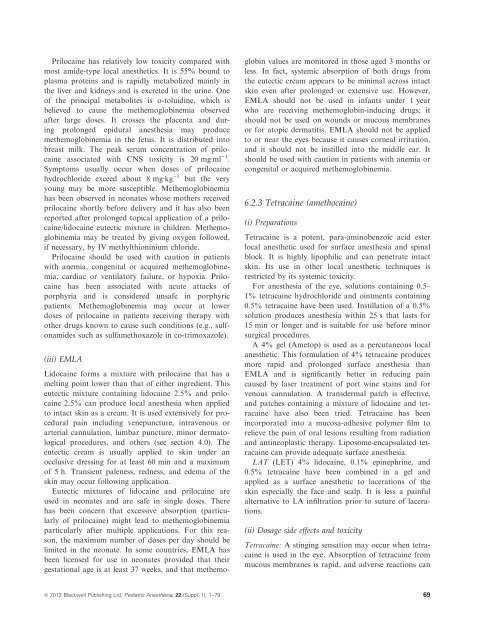Good Practice in Postoperative and Procedural Pain Management ...
Good Practice in Postoperative and Procedural Pain Management ...
Good Practice in Postoperative and Procedural Pain Management ...
You also want an ePaper? Increase the reach of your titles
YUMPU automatically turns print PDFs into web optimized ePapers that Google loves.
Priloca<strong>in</strong>e has relatively low toxicity compared withmost amide-type local anesthetics. It is 55% bound toplasma prote<strong>in</strong>s <strong>and</strong> is rapidly metabolized ma<strong>in</strong>ly <strong>in</strong>the liver <strong>and</strong> kidneys <strong>and</strong> is excreted <strong>in</strong> the ur<strong>in</strong>e. Oneof the pr<strong>in</strong>cipal metabolites is o-toluid<strong>in</strong>e, which isbelieved to cause the methemoglob<strong>in</strong>emia observedafter large doses. It crosses the placenta <strong>and</strong> dur<strong>in</strong>gprolonged epidural anesthesia may producemethemoglob<strong>in</strong>emia <strong>in</strong> the fetus. It is distributed <strong>in</strong>tobreast milk. The peak serum concentration of priloca<strong>in</strong>eassociated with CNS toxicity is 20 mgÆml )1 .Symptoms usually occur when doses of priloca<strong>in</strong>ehydrochloride exceed about 8 mgÆkg )1 but the veryyoung may be more susceptible. Methemoglob<strong>in</strong>emiahas been observed <strong>in</strong> neonates whose mothers receivedpriloca<strong>in</strong>e shortly before delivery <strong>and</strong> it has also beenreported after prolonged topical application of a priloca<strong>in</strong>e/lidoca<strong>in</strong>eeutectic mixture <strong>in</strong> children. Methemoglob<strong>in</strong>emiamay be treated by giv<strong>in</strong>g oxygen followed,if necessary, by IV methylthion<strong>in</strong>ium chloride.Priloca<strong>in</strong>e should be used with caution <strong>in</strong> patientswith anemia, congenital or acquired methemoglob<strong>in</strong>emia,cardiac or ventilatory failure, or hypoxia. Priloca<strong>in</strong>ehas been associated with acute attacks ofporphyria <strong>and</strong> is considered unsafe <strong>in</strong> porphyricpatients. Methemoglob<strong>in</strong>emia may occur at lowerdoses of priloca<strong>in</strong>e <strong>in</strong> patients receiv<strong>in</strong>g therapy withother drugs known to cause such conditions (e.g., sulfonamidessuch as sulfamethoxazole <strong>in</strong> co-trimoxazole).(iii) EMLALidoca<strong>in</strong>e forms a mixture with priloca<strong>in</strong>e that has amelt<strong>in</strong>g po<strong>in</strong>t lower than that of either <strong>in</strong>gredient. Thiseutectic mixture conta<strong>in</strong><strong>in</strong>g lidoca<strong>in</strong>e 2.5% <strong>and</strong> priloca<strong>in</strong>e2.5% can produce local anesthesia when appliedto <strong>in</strong>tact sk<strong>in</strong> as a cream. It is used extensively for proceduralpa<strong>in</strong> <strong>in</strong>clud<strong>in</strong>g venepuncture, <strong>in</strong>travenous orarterial cannulation, lumbar puncture, m<strong>in</strong>or dermatologicalprocedures, <strong>and</strong> others (see section 4.0). Theeutectic cream is usually applied to sk<strong>in</strong> under anocclusive dress<strong>in</strong>g for at least 60 m<strong>in</strong> <strong>and</strong> a maximumof 5 h. Transient paleness, redness, <strong>and</strong> edema of thesk<strong>in</strong> may occur follow<strong>in</strong>g application.Eutectic mixtures of lidoca<strong>in</strong>e <strong>and</strong> priloca<strong>in</strong>e areused <strong>in</strong> neonates <strong>and</strong> are safe <strong>in</strong> s<strong>in</strong>gle doses. Therehas been concern that excessive absorption (particularlyof priloca<strong>in</strong>e) might lead to methemoglob<strong>in</strong>emiaparticularly after multiple applications. For this reason,the maximum number of doses per day should belimited <strong>in</strong> the neonate. In some countries, EMLA hasbeen licensed for use <strong>in</strong> neonates provided that theirgestational age is at least 37 weeks, <strong>and</strong> that methemoglob<strong>in</strong>values are monitored <strong>in</strong> those aged 3 months orless. In fact, systemic absorption of both drugs fromthe eutectic cream appears to be m<strong>in</strong>imal across <strong>in</strong>tactsk<strong>in</strong> even after prolonged or extensive use. However,EMLA should not be used <strong>in</strong> <strong>in</strong>fants under 1 yearwho are receiv<strong>in</strong>g methemoglob<strong>in</strong>-<strong>in</strong>duc<strong>in</strong>g drugs; itshould not be used on wounds or mucous membranesor for atopic dermatitis. EMLA should not be appliedto or near the eyes because it causes corneal irritation,<strong>and</strong> it should not be <strong>in</strong>stilled <strong>in</strong>to the middle ear. Itshould be used with caution <strong>in</strong> patients with anemia orcongenital or acquired methemoglob<strong>in</strong>emia.6.2.3 Tetraca<strong>in</strong>e (amethoca<strong>in</strong>e)(i) PreparationsTetraca<strong>in</strong>e is a potent, para-am<strong>in</strong>obenzoic acid esterlocal anesthetic used for surface anesthesia <strong>and</strong> sp<strong>in</strong>alblock. It is highly lipophilic <strong>and</strong> can penetrate <strong>in</strong>tactsk<strong>in</strong>. Its use <strong>in</strong> other local anesthetic techniques isrestricted by its systemic toxicity.For anesthesia of the eye, solutions conta<strong>in</strong><strong>in</strong>g 0.5–1% tetraca<strong>in</strong>e hydrochloride <strong>and</strong> o<strong>in</strong>tments conta<strong>in</strong><strong>in</strong>g0.5% tetraca<strong>in</strong>e have been used. Instillation of a 0.5%solution produces anesthesia with<strong>in</strong> 25 s that lasts for15 m<strong>in</strong> or longer <strong>and</strong> is suitable for use before m<strong>in</strong>orsurgical procedures.A 4% gel (Ametop) is used as a percutaneous localanesthetic. This formulation of 4% tetraca<strong>in</strong>e producesmore rapid <strong>and</strong> prolonged surface anesthesia thanEMLA <strong>and</strong> is significantly better <strong>in</strong> reduc<strong>in</strong>g pa<strong>in</strong>caused by laser treatment of port w<strong>in</strong>e sta<strong>in</strong>s <strong>and</strong> forvenous cannulation. A transdermal patch is effective,<strong>and</strong> patches conta<strong>in</strong><strong>in</strong>g a mixture of lidoca<strong>in</strong>e <strong>and</strong> tetraca<strong>in</strong>ehave also been tried. Tetraca<strong>in</strong>e has been<strong>in</strong>corporated <strong>in</strong>to a mucosa-adhesive polymer film torelieve the pa<strong>in</strong> of oral lesions result<strong>in</strong>g from radiation<strong>and</strong> ant<strong>in</strong>eoplastic therapy. Liposome-encapsulated tetraca<strong>in</strong>ecan provide adequate surface anesthesia.LAT (LET) 4% lidoca<strong>in</strong>e, 0.1% ep<strong>in</strong>ephr<strong>in</strong>e, <strong>and</strong>0.5% tetraca<strong>in</strong>e have been comb<strong>in</strong>ed <strong>in</strong> a gel <strong>and</strong>applied as a surface anesthetic to lacerations of thesk<strong>in</strong> especially the face <strong>and</strong> scalp. It is less a pa<strong>in</strong>fulalternative to LA <strong>in</strong>filtration prior to suture of lacerations.(ii) Dosage side effects <strong>and</strong> toxicityTetraca<strong>in</strong>e: A st<strong>in</strong>g<strong>in</strong>g sensation may occur when tetraca<strong>in</strong>eis used <strong>in</strong> the eye. Absorption of tetraca<strong>in</strong>e frommucous membranes is rapid, <strong>and</strong> adverse reactions canª 2012 Blackwell Publish<strong>in</strong>g Ltd, Pediatric Anesthesia, 22 (Suppl. 1), 1–79 69
















